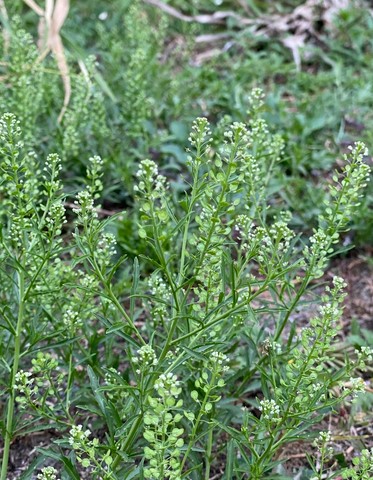Virginia Pepperweed Is Not Poisonous to Dogs or Cats.
So you know, we check the flowers we feature on our site with the ASPCA and do extensive internet research for both the common and scientific name just to be super pet safe. If we cannot find direct reference, we check up to genus and so on until we can confirm whether a plant is toxic or non toxic to both cats and dogs. If we are not sure, or get contradictory information, we do not include it. Many of the plants featured we have grown successfully in our own pet safe garden in Northern California. You can see many of garden stars in photos from Lovie’s Pet Safe Garden.

Physical Attributes
Virginia pepperweed (Lepidium virginicum) is a winter annual herb in the mustard family. It starts as a low-growing basal rosette of deeply lobed leaves. Mature plants have branching stems 6-20 inches tall with linear to lance-shaped stem leaves with toothed margins. Small whitish-yellow flowers form elongated racemes resembling thin bottlebrushes. Seeds are flat, round, lentil-shaped discs.[1][2][3][4]
General Care Tips
Virginia pepperweed readily self-sows and can be considered a weed in gardens and cultivated areas. It prefers dry, well-drained soils and full sun exposure. Allow soil to dry between waterings once established as it is drought tolerant. Deadhead spent blooms to prevent excessive self-seeding if desired. Can be grown intentionally for edible and ornamental purposes.[1][2][4]
Fun Facts
- All parts of the plant, including seeds and leaves, have a peppery taste that can substitute for black pepper.[1][3][5]
- Young leaves are edible and can be eaten raw in salads or sauteed. They contain protein, vitamin A and vitamin C.[1][5]
- The common name refers to its native range throughout Virginia and most of the eastern United States.[2][3]
- Virginia pepperweed is a larval host plant for checkered white and great southern white butterflies.[1]
- Dried seed stems can be used in dried flower arrangements.[1]
Citations:
[1] https://www.flawildflowers.org/flower-friday-lepidium-virginicum/
[2] https://www.weedalert.com/weed/virginia-pepperweed/
[3] https://weedid.cals.vt.edu/profile/664
[4] https://blogs.cornell.edu/weedid/virginia-pepperweed/
[5] https://blogs.ifas.ufl.edu/bakerco/2024/03/01/pepperweed/
| Consideration | Details |
|---|---|
| Container Friendly | Yes, can be grown in containers.[1][2] |
| Indoor/Outdoor | Outdoor[1][2][3][4][5] |
| Sun/Shade | Prefers full sun[1][3][4][5] |
| Perennial/Annual | Winter annual[1][2][3][4][5] |
| Flowering | Small white/yellow flowers in elongated racemes in spring/early summer.[3][4][5] |
| Drought Tolerant | Yes, drought tolerant once established.[1][2][4] |
| Pollinator Magnet | Yes, attracts butterflies and moths.[1][5] |
| Beginner Friendly | Yes, easy to grow and self-sows readily.[1][2][4] |
| Good Ground Cover | No, grows upright 6-20 inches tall.[1][3][4][5] |
| Good Privacy Screen | No, not tall enough for a privacy screen. |
| Invasive/Spreader | Can spread rapidly by self-seeding if not controlled.[1][2][3][4][5] |
| Hearty/Delicate | Hearty annual that tolerates poor soils.[1][2][4] |
| Rodent Repellent | Unknown, but peppery taste may deter some rodents. |
| Deer Resistant | Unknown, but peppery taste could make it deer resistant. |
| Ideal States | Native to eastern/central U.S., can grow across many regions like Virginia.[1][3][4] |
Citations:
[1] https://greg.app/virginia-pepperweed-benefits/
[2] https://www.picturethisai.com/care/Lepidium_virginicum.html
[3] https://weedid.cals.vt.edu/profile/664
[4] https://blogs.cornell.edu/weedid/virginia-pepperweed/
[5] https://www.weedalert.com/weed/virginia-pepperweed/





